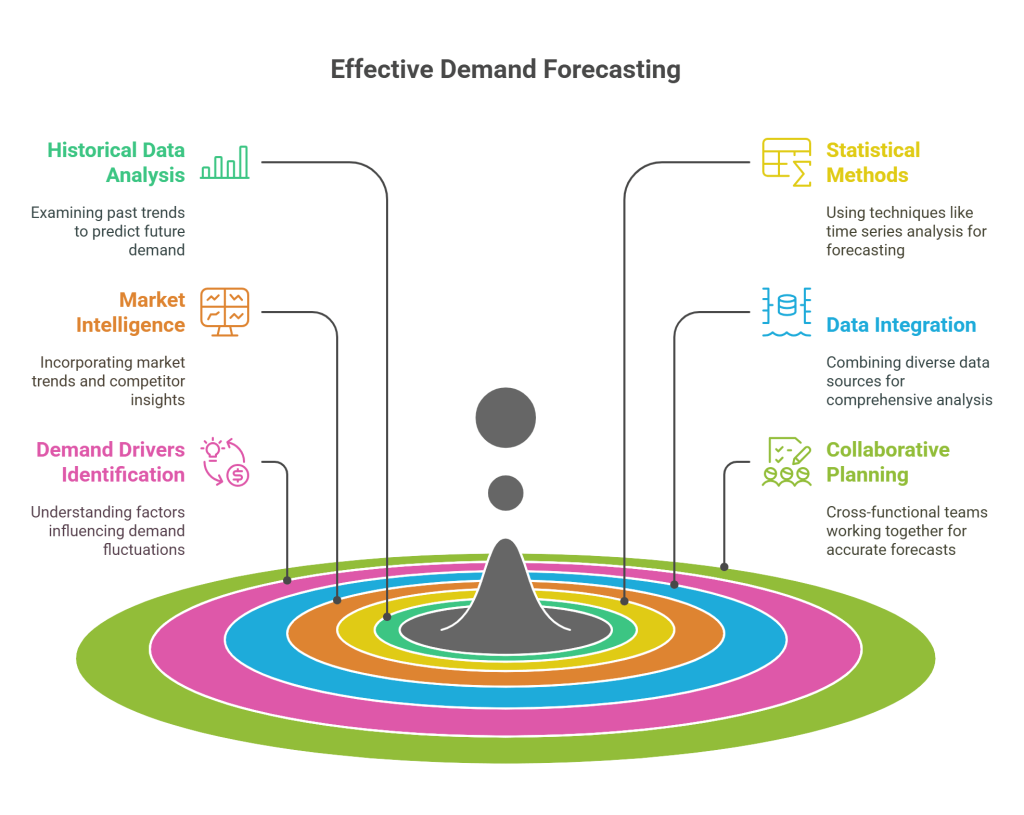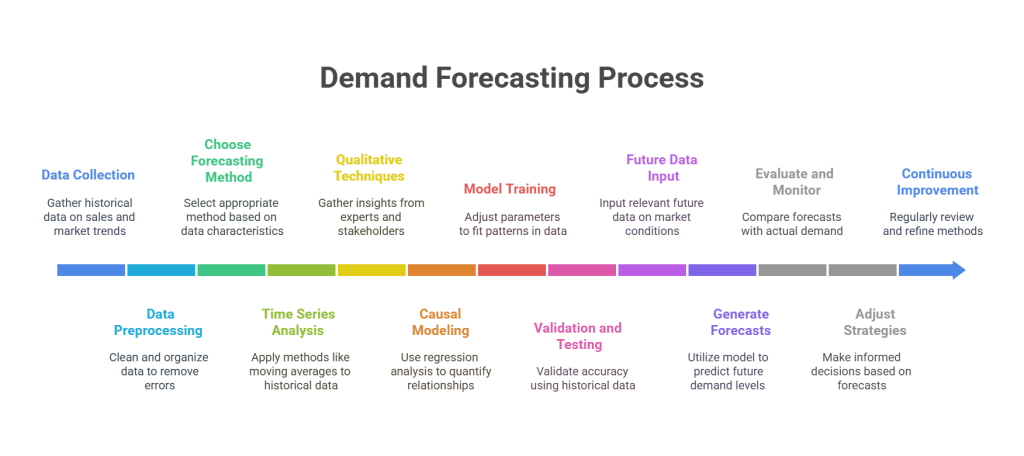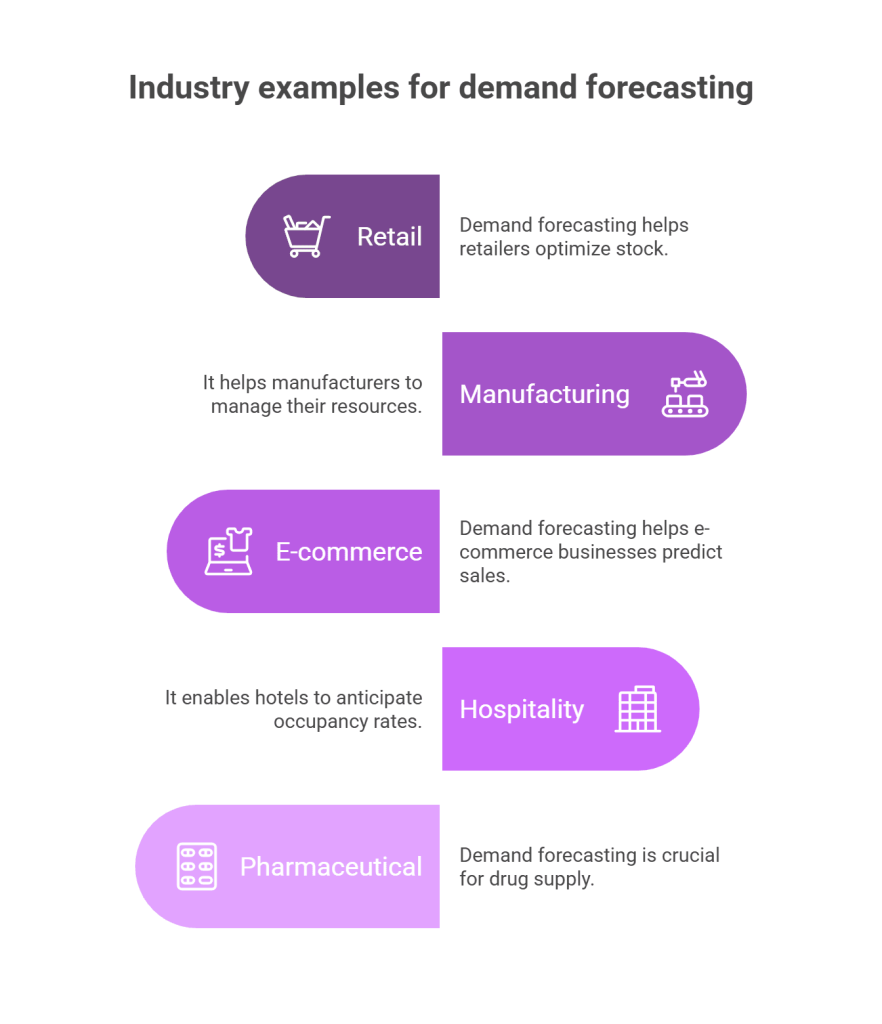In modern business dynamics, the demand forecasting importance cannot be overstated. It serves as the compass guiding organizations through the intricate maze of supply and demand. Demand forecasting illuminates the path towards optimal inventory management, resource allocation, and strategic decision-making by analyzing historical data, market trends, and external factors.
This predictive prowess empowers businesses to proactively meet customer needs, reduce excess inventory costs, and enhance overall operational efficiency. This comprehensive guide delves into the benefits, steps, and essential insights surrounding demand forecasting, shedding light on how this practice fuels informed and agile business strategies.

What Is Demand Forecasting?
Anticipating future demand for products or services, known as Demand Forecasting, holds immense importance in business planning. This strategic practice involves estimating the demand and considering customer preferences, market trends, and economic indicators.
The primary goal is to empower companies with valuable insights that aid in making well-informed choices related to production, inventory control, and resource distribution. Fundamentally, demand forecasting significantly influences a company’s capacity to uphold ideal stock quantities, optimize operational procedures, and elevate customer contentment.

Some of the key features that characterize effective demand forecasting includes:
1. Historical Data Analysis
Historical data analysis involves examining past sales and demand patterns to uncover trends, seasonality, and any anomalies. By analyzing historical data, businesses can identify recurring patterns, such as higher sales during certain seasons or periods, as well as irregularities caused by external factors like economic downturns or promotional events. This information forms the basis for creating accurate forecasts by extrapolating these patterns into the future.
2. Statistical Methods
Statistical techniques are essential tools for demand forecasting. Time series analysis, for instance, involves analyzing data points in chronological order to identify trends, seasonal variations, and cyclic patterns. Moving averages help smooth out short-term fluctuations, making it easier to recognize underlying trends. Exponential smoothing assigns different weights to different data points, placing more emphasis on recent observations while damping the impact of older ones. These methods aid in creating predictive models that can capture the nuances of demand fluctuations.
3. Market Intelligence
Demand forecasting doesn’t occur in isolation; it’s deeply connected to the broader market landscape. Incorporating market intelligence involves studying competitor behavior, consumer preferences, economic conditions, and external factors that could impact demand. For instance, an impending change in regulations might lead to a spike in demand for certain products before the new regulations take effect. By incorporating such insights, businesses can refine their forecasts to reflect the dynamic nature of the market.
4. Data Integration
Modern businesses generate vast amounts of data from various sources, including sales, marketing campaigns, customer feedback, and external data feeds. Integrating these diverse data sources provides a comprehensive view of market dynamics. Data integration ensures that all relevant information is considered when building forecasts, leading to more accurate predictions. It also enables businesses to uncover relationships between factors affecting demand.
5. Demand Drivers Identification
Understanding the factors influencing demand is crucial for accurate forecasting. Demand drivers can range from pricing changes and promotional activities to consumer behavior and preferences shifts. By identifying these drivers, businesses can adjust their forecasts accordingly. For instance, a product launch campaign might result in a temporary spike in demand, which should be factored into the estimates to ensure adequate production and inventory levels.
6. Collaborative Planning
Demand forecasting benefits from collaboration among different departments within a company, such as sales, marketing, and operations. Cross-functional teams bring diverse perspectives to the table, helping to identify potential blind spots and ensuring that forecasts are well-rounded and comprehensive. Collaborative planning can lead to more accurate predictions, as input from different teams can help capture insights that might not have been apparent otherwise.
Incorporating these features into the demand forecasting process enhances the accuracy and reliability of predictions. Demand forecasting is a dynamic and ongoing process that involves continuous refinement and adaptation based on new data, market shifts, and emerging trends. Businesses leveraging these features can make more informed decisions, optimize their resources, and respond more effectively to market changes.
How Does Demand Forecasting Work?
Demand forecasting is a vital component of business planning known as anticipating future customer demand for a product or service. This practice allows companies to make well-informed choices regarding production, inventory management, resource distribution, and marketing approaches.
Demand forecasting operates through a systematic process that utilizes historical data, statistical analysis, market trends, and other relevant factors to predict future demand levels accurately. This process helps businesses to optimize their operations, minimize risks, and meet customer expectations effectively.

Let us explore how Demand forecasting works in a step-by-step process.
STEP 1: Data Collection:
Gather relevant historical data on product sales, customer behavior, market trends, and external factors (economic indicators, social events, etc.) that can impact demand.
STEP 2: Data Preprocessing:
Clean and organize the collected data to remove errors, inconsistencies, and outliers that could distort the forecasting process.
STEP 3: Choose Forecasting Method:
Select an appropriate forecasting method based on the characteristics of the data and the business’s requirements. Standard methods include time series analysis, qualitative techniques, and causal modeling.
STEP 4: Time Series Analysis:
If historical data exhibits a clear pattern, time series analysis methods like moving averages, exponential smoothing, and ARIMA (AutoRegressive Integrated Moving Average) can be applied.
STEP 5: Qualitative Techniques:
When historical data is insufficient or unreliable, qualitative methods like expert opinion, market research, and the Delphi method involve gathering insights from industry experts and stakeholders.
STEP 6: Causal Modeling:
If factors directly influence demand (like price changes or marketing campaigns), causal modeling methods like regression analysis help quantify these relationships.
STEP 7: Model Training:
Apply the chosen forecasting method to the historical data, adjusting parameters and training the model to fit the patterns within the data.
STEP 8: Validation and Testing:
Use a portion of the historical data to validate the accuracy of the forecasting model. Adjust and fine-tune the model if needed.
STEP 9: Future Data Input:
With the validated model, input relevant future data on market conditions, economic indicators, and potential influencing factors.
STEP 10: Generate Forecasts:
Utilize the trained model to generate forecasts for future demand levels. The model will provide predictions along with confidence intervals or probabilities.
STEP 11: Evaluate and Monitor:
Compare the generated forecasts with actual demand as time progresses. Regularly update the model with new data to improve its accuracy over time.
STEP 12: Adjust Strategies:
Based on the forecasted demand, businesses can make informed decisions regarding production, inventory management, staffing, marketing campaigns, and resource allocation.
STEP 13: Continuous Improvement:
Demand forecasting is an iterative process. Regularly review and refine the forecasting methods and models to adapt to changing market dynamics and improve accuracy.
Incorporating these steps, demand forecasting helps businesses anticipate market fluctuations, optimize resource allocation, and enhance overall operational efficiency.
Overview of Demand Forecasting Types
Demand forecasting is a critical aspect of business planning that predicts future customer demand for a product or service. It aids in effective resource allocation, production scheduling, inventory management, and overall strategic decision-making.
Several demand forecasting methods exist, each tailored to different scenarios and levels of data availability. These methods can be broadly categorized into quantitative and qualitative approaches.
Some of the popular ones are listed below :
1. Time Series Analysis:
Time series forecasting involves analyzing historical demand data to identify patterns and trends. Techniques like moving averages, exponential smoothing, and ARIMA (AutoRegressive Integrated Moving Average) models are commonly used to make predictions based on past demand data.
2. Causal / Regression Analysis:
This method considers factors influencing demand, such as economic indicators, marketing efforts, or competitor actions. Businesses can predict future direction using regression analysis or other statistical techniques by establishing relationships between these variables and demand.
3. Market Research:
Qualitative market research involves gathering insights from customer surveys, focus groups, expert opinions, and other qualitative data sources. This approach benefits new products or markets where historical data might be limited.
4. Delphi Method:
The Delphi method involves collecting opinions and forecasts from a panel of experts in a specific industry or field. These experts provide their insights anonymously and iteratively, allowing for refining projections based on collective wisdom.
5. Technology-Driven Forecasting:
With the advent of advanced technologies like artificial intelligence and machine learning, businesses can leverage sophisticated algorithms to process vast amounts of data from diverse sources. These methods can identify complex patterns and relationships, enhancing the accuracy of demand forecasts.
Each of these demand forecasting methods has its strengths and limitations. Businesses often combine these approaches to create a well-rounded and reliable prediction of future demand, enabling efficient operations and strategic decision-making.
Examples of Demand Forecasting
The importance of demand forecasting involves predicting future customer demand for a product or service to make informed business decisions. Accurate demand forecasting helps companies optimize inventory levels, production schedules, and resource allocation.

Here are five examples of demand forecasting in various industries:
1. Retail Industry
Retailers use demand forecasting to anticipate consumer demand for products and plan their inventory accordingly. For instance, retailers might predict increased demand for specific items like toys or electronics during the holiday season. They analyze historical sales data, seasonal trends, promotional activities, economic indicators, and even external factors like weather forecasts to make accurate predictions. Doing so can ensure they have enough stock to meet customer demands without overstocking and tying up capital.
2. Manufacturing Industry
Manufacturing companies use demand forecasting to plan production schedules and optimize resource allocation. For instance, an automobile manufacturer must predict demand for various car models and their components. They consider factors like historical sales data, market trends, economic conditions, and the introduction of new models. This helps them manage their supply chain efficiently, reduce production bottlenecks, and avoid excess inventory.
3. E-commerce Industry
E-commerce platforms rely heavily on demand forecasting to manage inventory and ensure quick order fulfillment. These platforms can predict which products will likely be in demand by analyzing customer browsing behavior, past purchases, and seasonal trends. They can then adjust their inventory levels and distribution strategies to meet customer expectations and minimize stockouts.
4. Hospitality Industry
In the hospitality sector, demand forecasting is essential for hotels and airlines. Hotels use historical booking data, local events, and seasonal trends to predict room occupancy rates. Airlines use similar techniques to forecast flight bookings and adjust pricing accordingly. This allows them to optimize revenue by offering the correct number of rooms or seats at the right prices.
5. Pharmaceutical Industry
Pharmaceutical companies use demand forecasting to ensure a steady supply of medications and medical supplies. They consider disease prevalence, patient demographics, regulatory changes, and market trends. For example, accurate demand forecasting becomes crucial for producing vaccines and necessary medical equipment to meet the increased demand during a pandemic.
In all these examples, advanced technologies like machine learning and artificial intelligence have revolutionized demand forecasting . These technologies can handle large datasets and complex patterns, making predictions more accurate. Organizations also have the option to integrate up-to-the-minute information, like analyzing public sentiment on social media or tracking online search patterns, to enhance the precision of their predictive efforts.
In the end, demand forecasting supports enterprises in making well-informed choices, cutting down expenses, streamlining operations, and boosting customer contentment, all by ensuring the availability of products and services at the right time and place.
Conclusion
In conclusion, we can say that demand forecasting holds paramount importance in modern business strategies. Companies can optimize their operations, reduce costs, and maintain customer satisfaction by accurately predicting customer preferences and market trends.
Organizations can harness the power of foresight to stay ahead in a competitive landscape through meticulous steps involving data collection, analysis, and model selection. To streamline this process, Qodenext emerges as a reliable partner, offering cutting-edge solutions for effective demand forecasting. Embrace the future with Qodenext and elevate your demand forecasting strategies for sustained success.
FAQs:
1. What is demand forecasting, and why is it crucial for businesses?
Demand forecasting is the process of predicting future customer demand using historical data and market trends, and it’s crucial because it helps businesses plan better, avoid stockouts or overproduction, reduce costs, and meet customer needs more effectively.
2. How does demand forecasting improve inventory management?
It improves inventory management by helping businesses maintain optimal stock levels, ensuring products are available when needed without overstocking, which reduces storage costs and increases efficiency.
3. What are the common methods used in demand forecasting?
Common methods include qualitative approaches like expert opinions, quantitative models like time-series analysis and regression, and modern techniques like machine learning, all used depending on data availability and business needs.
4. How can small businesses implement demand forecasting effectively?
Small businesses can implement it effectively by tracking past sales data, identifying seasonal trends, starting with simple spreadsheet models, and gradually adopting affordable forecasting tools as they scale.
5. What tools or software are recommended for demand forecasting?
Recommended tools include Excel for beginners, Zoho Inventory and QuickBooks Commerce for growing businesses, and more advanced options like NetSuite Demand Planning or Forecast Pro for detailed and automated forecasting.






